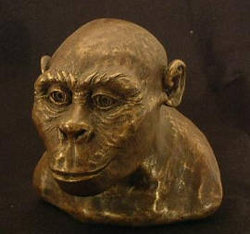Australopithecine
|
|
| Australopithecines Conservation status: Fossil | ||||||||||||
|---|---|---|---|---|---|---|---|---|---|---|---|---|
 | ||||||||||||
| Scientific classification | ||||||||||||
| ||||||||||||
| Species | ||||||||||||
|
A. afarensis ("Lucy") |
Australopithecines (genus Australopithecus) are a group of extinct hominids that are closely related to humans. A. afarensis and A. africanus are among the most famous of the extinct hominids. A. africanus used to be regarded as ancestral to the genus Homo (in particular Homo erectus). However, fossils assigned to the genus Homo have been found that are older than A. africanus. Thus, the genus Homo either split off from the genus Australopithecus at an earlier date (the latest common ancestor being A. afarensis or an even earlier form), or both developed from an as yet possibly unknown common ancestor independently. The australopithecines first appeared roughly 4.2 million years ago.
The brains of most species of Australopithecus were roughly 35 percent of the size of that of a modern human brain. Most species of Australopithecus were diminutive and gracile, usually standing no more than 1.2 m tall.
The fossil record seems to indicate that Australopithecus is the common ancestor of the distinct group of hominids, now called Paranthropus, and the genus Homo, which includes modern humans. Both genera were more advanced in their behavior and habits than Australopithecus, which were little more than bipedal chimpanzees. However, it is believed that only representatives of Homo would develop language and learn to control fire.
Although opinions differ as to whether the species aethiopicus, boisei and robustus should be included within the genus Australopithecus, the current consensus in the scientific community is that they should be placed in a distinct genus, Paranthropus, which is believed to have developed from the ancestral Australopithecus line. Up until the last half decade the majority, however, included all the species shown at right in a single genus. Paranthropus, being more massive and robust, was also morphologically distinct from Australopithecus, and its specialized physiology also implies that its behavior was quite different from that of its ancestor.
The existence of Australopithecus seems to have put firmly to rest the theory that human-like intelligence evolved first and bipedalism followed. Australopithecus had a brain case not significantly larger than a modern chimpanzee. Yet Australopithecus was certainly bipedal, suggesting it was bipedalism which made human-like intelligence possible and not the other way around.
Most species of Australopithecus were not any more adept at tool use than modern primates. However, Australopithecus garhi does appear to have been the most advanced of the line. Its remains have been found with tools and butchered animal remains, suggesting the incipience of a very primitive tool industry. This leads many scientists to suspect that A. garhi is the ancestor of the Homo genus.
On 31 March 1994 the journal Nature reported the finding in Ethiopia of the first complete Australopithecus afarensis skull.
See also
eo:Auxstralopitekoj fr:Australopithèque it:Australopithecus ja:ã¢ã¦ã¹ãã©ãããã¯ã¹å± lt:Australopitekas nl:Australopithecus pl:Australopiteki pt:Australopithecus sl:avstralopitek sv:Australopithecus zh:南方古猿
